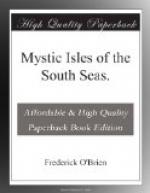Choti put him the question of my habitation, and he instantly offered me either a room in his own house or a small, native building on the opposite side of the road and nearer the beach. We walked over, and found it unoccupied. It was a bird-cage, all one room, with a thatch of pandanus and a floor of dried grass covered with mats. The walls were of split bamboo, like reeds, and the sun and air penetrated it through and through; but hanging mats were arranged, one as a door, and others to keep out the rain. It was exactly suited for sleeping and lounging purposes, and the chief said that I could cook in a convenient hut. I brought in my belongings, which included bedding, and in half an hour was enough at home to dismiss the coachman and his equipage, and to lie down, as was my wont during the heat of the day. I put my bed in the doorway, and before I fell into my first sleep at Tautira, filled my eyes with the blue of the shimmering lagoon and the hoary line of the reef. I sank into dreams, with the slumbrous roar upon the coral barrier like the thunder of a sea god’s rolling drum.
Chapter XXIII
My life at Tautira—The way I cook my food—Ancient Tahitian sports—Swimming and fishing—A night hunt for shrimp and eels.
T’yonni and Choti were the only aliens except myself in all Tautira, nor did others come during my stay. The steamships, spending only twenty-four hours in Papeete port every four or five weeks, sent no trippers, and the bureaucrats, traders, and sojourners in Papeete apparently were not aware of the enchantment at our end of the island. T’yonni had found Tautira only after four or five voyages to Tahiti, and Choti had first come as his guest. T’yonni had no art but that of living, while Choti had studied in Paris, and was bent on finding in these scenes something strong and uncommon in painting, as Gauguin, now dead, had found. They lived separately, T’yonni studying the language and the people,—he had been a master at a boys’ school in the East,—and the artist painting many hours a day. But we three joined with the villagers in pleasure, and in pulling at the nets in the lagoon.
The routine of my day was to awake about six o’clock and see the sun swinging slowly up out of the sea and hesitating a moment on the level of the horizon, the foliage brightened with his beams. I sprang from my bed, washed my hands and face, and hastened to the fare umu, the kitchen in a grove of pandanus trees, a few steps away. There from a pile of cocoanut husks and bits of jetsam I selected fuel, which I placed between a group of coral rocks on which were several iron bars. I lit the fire, and put into a pot three tablespoonfuls of finely ground coffee and two cups of fresh water. The pot was a percolator, and beside it I placed a frying-pan, and in it sliced bananas and a lump of tinned butter from New Zealand. Leaving these inanimate things to react under the




